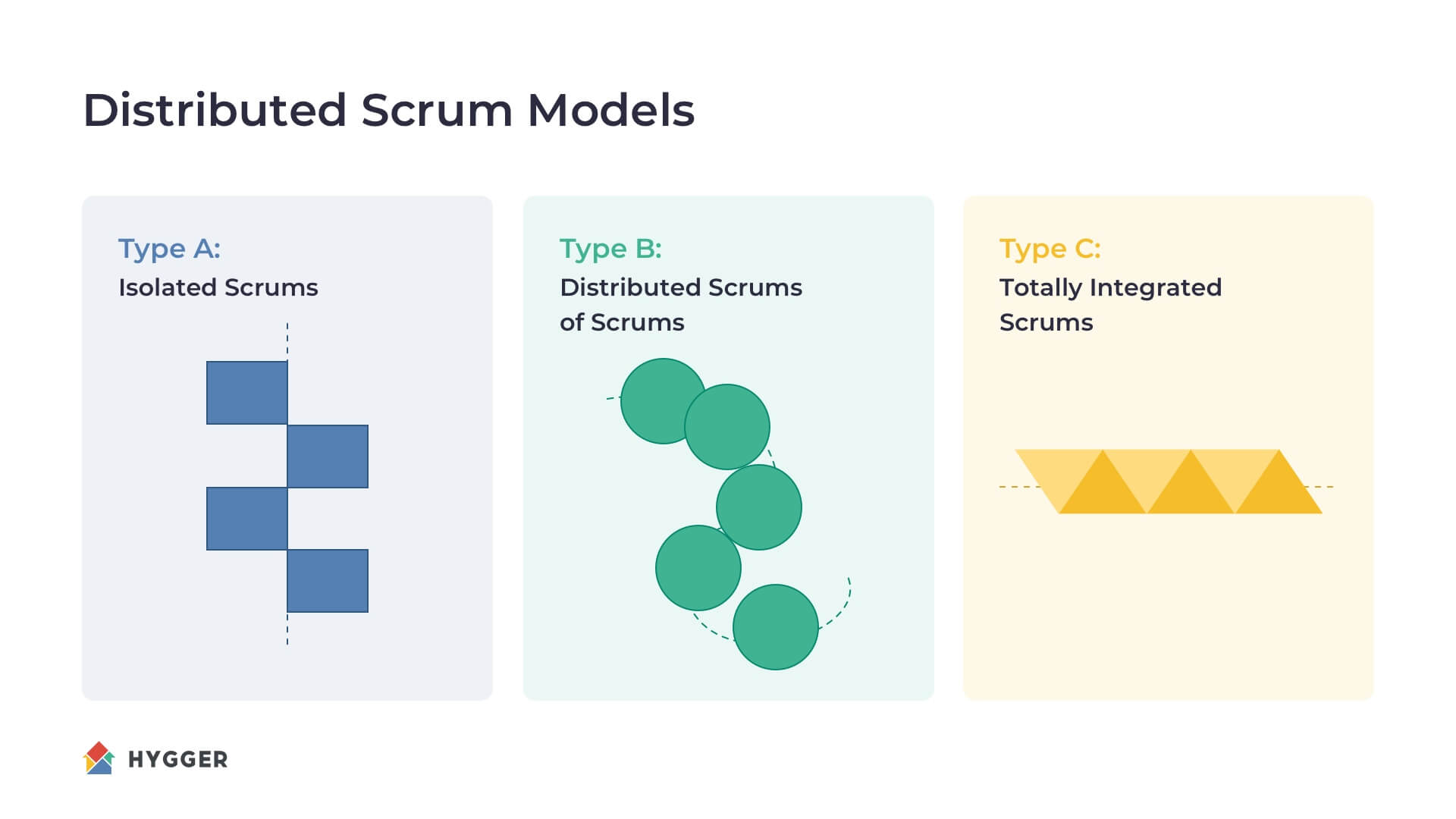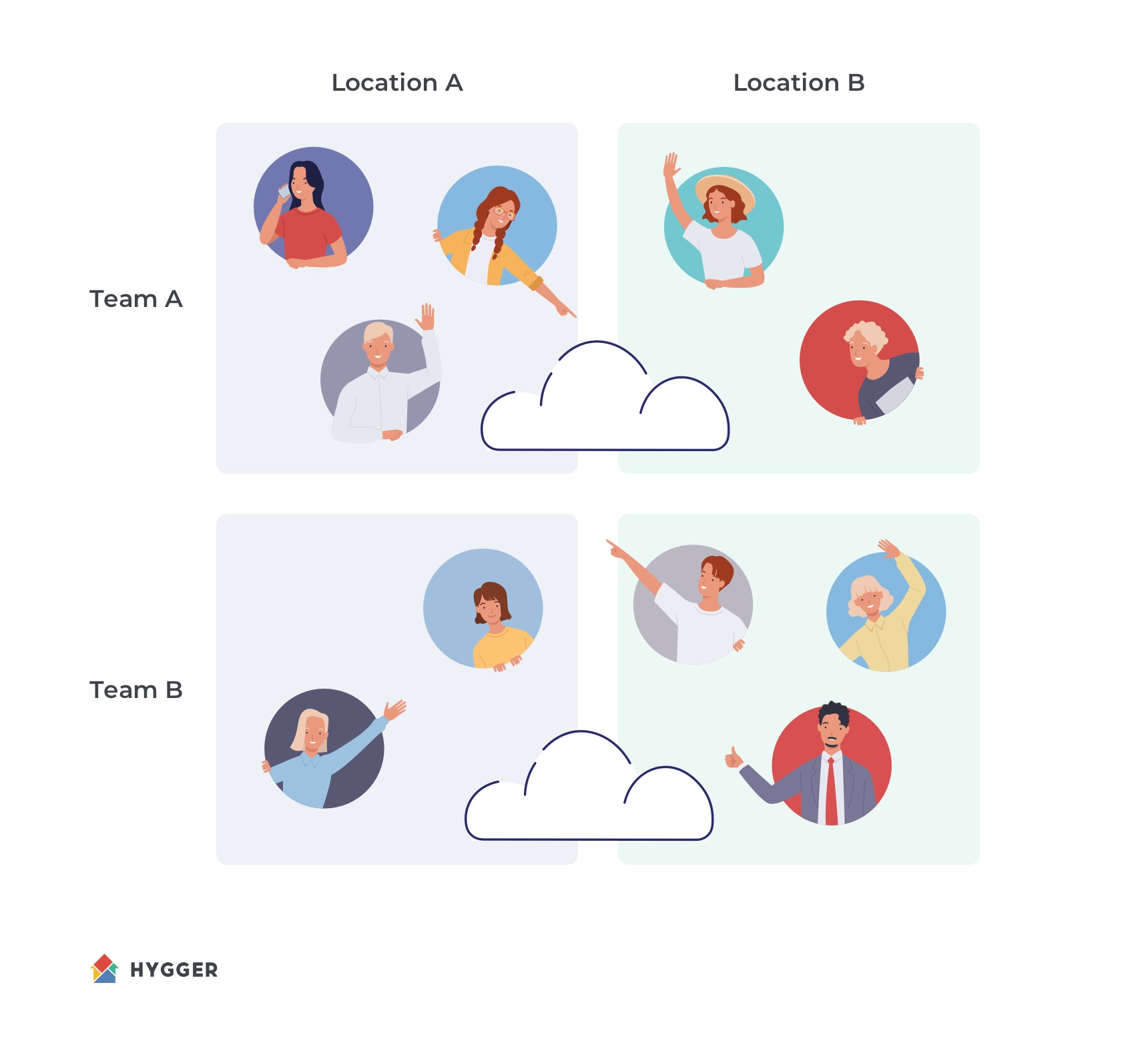Distributed Scrum Team
What are the benefits of working remotely within a Scrum team?
Browse topics
Scrum is one of the most reliable methodologies for software development projects that many organizations apply today. Scrum requires having a co-located team for better communication and increased productivity. However, business needs and unforeseen circumstances (such as the spread of Coronavirus) force many companies to have teams distributed across the globe. We won’t be surprised if, by the middle of 2021, more than half of the company’s workforce will be working virtually.

This is actually the world’s largest work-from-home experiment provoked by COVID-19. Many studies prove that distributed workers are extremely productive and have a higher satisfaction level.
So, how are remote work and Scrum compatible? Does Agile work with distributed teams and can a Scrum Master work remotely? Let’s figure it out right now!
Distributed Scrum Team Definition
What Is a Distributed Team?
A distributed team is a term that refers to a group of people where all members are physically located away from each other. It means that being a distributed team member, you can work from home, a cafe, a park, or co-working spaces. For example, you could be a Head of Marketing living in Lisbon, managing an SMM specialist based in Rome, a video manager who lives in Paris, and a web designer working out of Acapulco.
A distributed team can be also called a virtual team or a remote team. It can be defined as:
- A group of individuals who work in the same team but cooperate from different locations. For example, a single team with employees in New York, Moscow, and Berlin would be a distributed team.
- Different collaborating teams that are not located in the same place. This is mostly about large-scale development. For example, a large project might need a team in New York, another in Moscow, and the third one in Berlin. These teams are distributed, as each team is located in a different city.

What Is a Scrum Team?
A Scrum team is a group of specialists (usually between five and nine members) working together to deliver the required product increments. Scrum encourages a high level of communication among team players so that the team could follow a common goal, adhere to the same rules, and demonstrate respect to each other.
What Is a Distributed Scrum Team?
What is distributed team in Agile? A distributed Scrum team is a regular Scrum team that is fully or partially remote. If you want your remote Scrum team to be efficient, you should keep in mind new approaches to adopting Scrum needs.
Remote Scrum teams have constraints on ad hoc collaboration and informal communication, so they have to be more disciplined about all Agile rituals and find new opportunities to collaborate. Luckily, most of the Scrum rituals and tools can be adapted to the virtual remote environment (including sprints and all Scrum ceremonies).
There is a popular practice called the “Two Pizza rule”, according to which all team members could be fed just by two pizzas. It means that a team should include up to 7-10 people. This rule is recommended to follow for most Agile-focused teams. However, for remote work, it’s better to have smaller teams with 5-6 people.
What Are the Distributed Team Models?
There are three distributed Scrum models well-known in a virtual work management practice:
- Isolated Scrum teams that are isolated across geographies. In most cases, off-shore teams are not crossfunctional and may not be using the Scrum process.
- Distributed Scrum of Scrums that are isolated across geographies and integrated by a Scrum of Scrums that meets regularly across geographies.
- Totally Integrated Scrum teams that are cross-functional with members distributed across geographies.
Many outsourced development companies practice a degenerative form of the Isolated Scrums model where the teams are not cross-functional and not Agile-oriented. Requirements can be created in China and developed in India, or development may occur in Italy and quality assurance in Russia.
Who Can Have Distributed Scrum Teams?
A Remote Scrum teams model is a proper solution in case your organization falls into any of these categories:
- A company starting something new;
- A company that requires flexible and quick scaling;
- A company looking to hire people quickly;
- A company with a team having some skill gaps.
Distributed Teams Benefits: Why Do We Choose Virtual Scrum Teams?
Fast-changing market conditions and scaling teams are crucial for businesses, so virtual teams can be considered the latest trend in workplace development. In order to work with the best people in the industry, many organizations have to adapt to these changes.
In fact, this concept is becoming a common organizational model as technology is making it easier for individuals to work from any place. Ultimately, both companies and employees get benefits from remote teams.
What Are the Team Benefits?
- Flexible working hours
- Increased self-confidence
- Reduced stress levels
- Advanced work-life balance
- Optimized commuting time
- Enhanced productivity
What are the Business Benefits?
- More productive workforce
- Closeness to customers
- Fewer costs
- Ability to hire talents anywhere

What Are the Possible Challenges of Distributed Scrum Teams?
Despite all its benefits, managing a distributed development Scrum team is not that easy. You may face many challenges when working remotely. Here we list some as well as the ways to handle them.
1. Lack of Communication
It is actually not an easy thing to communicate with the team members working from across globally. The lack of communication happens because of different time zones. This can cause delays in the work and make distributed employees feel lonely. As a possible solution, you can establish the right communication channels that will help everyone to get the right info at the right time.
2. Different Time Zones
As we’ve mentioned above, distributed software development teams often include employees located across different time zones. Scheduling meetings for them could be a real challenge as it is difficult to choose a time that is appropriate for everyone. In this case, you may contact each other through emails. Just send all relevant questions to your colleagues and ask them to answer and share their problems.
3. Problems with Adopting the Corporate Culture
This problem happens mainly as the distributed team members have different communication styles, values, contexts, and work ethics. That’s why their cultures may differ completely.
Tracking remote employees’ behavior and activities is essential to achieve success. As face-to-face meetings can take a long time, you may plan to gather all the remote team members together once every few months.
4. Lack of Strong Relationships
Building long-term relationships with team members is one of the most essential responsibilities of the remote manager. However, as you communicate less frequently with your distributed colleagues, strengthening relationships becomes even more complex. Looking for a solution, be more open. Encourage your team members to share their problems with you. Find the ideal solution to their problems to let them perform well.

How to Build an Effective Distributed Scrum Team
Any distributed software development team should follow the main Scrum principles of transparency, clear communication, and a dedication to continuous improvement. The success of such a group of people depends on mutual trust, communication, and collaboration.
A remote Scrum team can benefit from a reliable communication plan that includes:
- Remote work agreements;
- The agreements for how meetings should be structured;
- Ways to contact other colleagues for informal questions;
- How remote team members communicate their availability;
- What collaboration tools should be applied.
What Collaboration Tools Сan be Used to Make Remote Work more Effective?
All forms and models of Agile remote working require effective collaboration tools.
Scrum teams usually apply Agile planning tools to collect stories/requirements, report and manage issues, and track progress.
Distributed employees should have a handy virtual whiteboard that will provide visibility of project steps and workflows. For this aim, Hygger’s online Kanban boards suit perfectly well.
Whatever you use, this tool should:
- Enable collaboration, notification, and sharing features;
- Be accessible to all remote team members;
- Be a collection of relevant and engaging information.
You may also use video-conferencing tools, for example, Zoom for impromptu communication.
If you desire to dive deeper into this topic, feel free to explore our post about 20 Online Tools Enhancing the Process of Managing Remote Teams.

Essential Factors Leading to Successful Scrum Teams Working Remotely
1. Avoid Handoffs
Handoffs to/from a Scrum team increase risks and information scatter. Up to 50% of information can be lost when there is a handoff. Handoffs may happen when others outside the team prepare docs and hand them to the team.
2. Choose an Appropriate Team Size
An ideal Agile team should contain 5-9 team members, excluding the Scrum Master and PO.
3. Support the Team in Self-Organization
No one outside the team should tell them how to operate. People closer to the work should make the decisions about how the work is done. This autonomy fosters ownership of results and supports internal motivation.
4. Encourage Psychological Safety
High-performing teams have psychological safety. This safety is what the team members feel about taking risks, making mistakes, and doing what they think is right without feeling embarrassed and insecure.
5. Ensure the Maturation Process
A new team consists of beginners who are immature. Their performance will be not optimal until they mature into a high-performing group. Distributed Scrum teams may have little time overlapping, speak different languages, and work in different conditions to take longer to mature and perform at a high level.
6. Eliminate Sub-Teams
Creating sub-teams may lead to bottlenecks and a lack of end-to-end ownership for the results.
7. Focus on Software over Documentation
Agile values working software over comprehensive documentation. The focus should be on the solution delivery, not the paperwork that describes this solution.
8. Provide Cross-Training and Learning
Scrum teams that cross-train each other and learn from each other tend to work better. When employees are immature, they often gravitate toward each person doing just one thing. It may cause bottlenecks and key person dependencies. Teams that constantly train and learn reduce or eliminate these bottlenecks.
9. Focus on People and Interactions over Process and Tools
High-performing teams require a key focus on getting the right people on the team and helping them to work well together. Tools and processes are important, but not as important as having the right individuals.
Wrapping Up
Do remote teams have a bright future?
Today distributed teams provide valuable benefits not just for companies, but importantly for employees. The number of remote workers is increasingly growing and this becomes one of the major project and product management trends.
More and more companies are getting a taste of what it means to have a distributed workforce, no matter they have the infrastructure to support telecommuting or not. It’s likely distributed teams will stay even after the Pandemic, at least in some capacity.
Do you have distributed projects and remote colleagues? How do you structure your Scrum development team? After all, what do you think about the future of virtual teams? Please, share your thought below!
